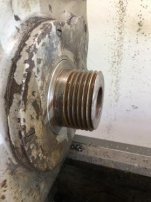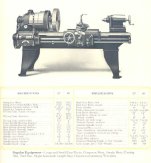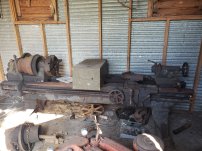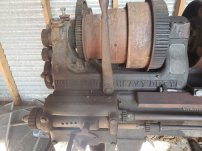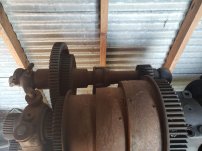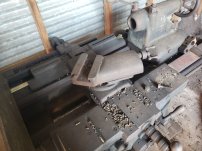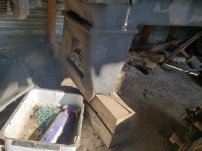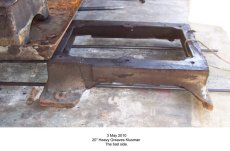Joe Michaels
Diamond
- Joined
- Apr 3, 2004
- Location
- Shandaken, NY, USA
I was at the local industrial surplus store yesterday and spotted a faceplate/driveplate sitting on the floor. I included it in a random lot of other stuff I had found. For the price, I figured it might be of some use to one of the members here. The dimensions and description are as follows:
Outer diameter = 10 1/4"
Hub outer diameter = 3"
Register inner diameter: 2. 297"
Register is machined with a heavy radius at the mouth of the bore, instead of the more usual square corner. There is still a flat land for seating the hub against the collar on the spindle.
Spindle threads: 6 threads/inch
Interesting design in that this plate has two (2) slots which are open at the rim, as a driveplate would have. (2) other slots have 'closed ends' (not extending out to the rim)
The design, having two open - ended slots and two closed slots leads me to think this was made as a combination drive (or dog) plate and small faceplate.
Condition: light surface rust on the face of the plate and rim, no signs of any real use, no gouges, dings, or damage.
6 threads/inch for a spindle nose and the odd diameter of the register bore do not bring any of the well known manufacturers' spindle nose dimensions to mind. If anyone has a clue what lathe this was for, I'd appreciate learning that much.
If anyone has any use for this plate, I am happy to let it go for 10 bucks (which is about what I have in it) plus shipping via USPS. The plate seemed too good to let sit on the concrete floor in an odd corner of the surplus store. It's lots easier to bring home a stray lathe drive plate than a stray dog or cat.
Outer diameter = 10 1/4"
Hub outer diameter = 3"
Register inner diameter: 2. 297"
Register is machined with a heavy radius at the mouth of the bore, instead of the more usual square corner. There is still a flat land for seating the hub against the collar on the spindle.
Spindle threads: 6 threads/inch
Interesting design in that this plate has two (2) slots which are open at the rim, as a driveplate would have. (2) other slots have 'closed ends' (not extending out to the rim)
The design, having two open - ended slots and two closed slots leads me to think this was made as a combination drive (or dog) plate and small faceplate.
Condition: light surface rust on the face of the plate and rim, no signs of any real use, no gouges, dings, or damage.
6 threads/inch for a spindle nose and the odd diameter of the register bore do not bring any of the well known manufacturers' spindle nose dimensions to mind. If anyone has a clue what lathe this was for, I'd appreciate learning that much.
If anyone has any use for this plate, I am happy to let it go for 10 bucks (which is about what I have in it) plus shipping via USPS. The plate seemed too good to let sit on the concrete floor in an odd corner of the surplus store. It's lots easier to bring home a stray lathe drive plate than a stray dog or cat.



